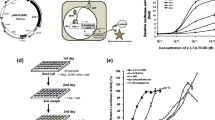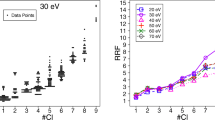Abstract
Pentachlorophenol (PCP), a widely-used aseptic or biocide, is known as an environmental toxicant involved in endocrine disruption even at a trace level. In order to reliably and efficiently quantify environmental trace-quantity PCP, this study developed a novel PCP detection method using the aryl hydrocarbon receptor (AhR) and fluorescence quantitative PCR (qPCR). DNA probe with AhR binding sites was synthesized by PCR before added into AhR–PCP complex. After AhR–PCP–DNA complex was digested with exonuclease, copy number of DNA probe was determined using fluorescence qPCR. To calculate PCP concentration in samples, a standard curve (PCP concentration versus Ct value) was constructed and the detection range was 10−13 to 10−9 M. PCP detection limit was 0.0089 ppt for the AhR–PCP–DNA complex assay and 8.8780 ppm for high performance liquid chromatography, demonstrating that the method developed in this study is more sensitive. These results suggest that AhR–PCP–DNA complex method may be successfully applicable in detection and quantification of environmental trace-level PCP.





Similar content being viewed by others
References
Bagnyukova T, Luzhna L, Pogribny I, Lushchak V (2007) Oxidative stress and antioxidant defenses in gold fish liver in response to short-term exposure to arsenite. Environ Mol Mutagen 48:658–665
Bank PA, Yao EF, Pheips CL, Harper PA, Denison MS (1992) Species-specific binding of transformed Ah receptor to a dioxin responsive transcriptional enhancer. Environ Toxicol Pharmacol 228:85–94
Bartelt G, Buge HG, Gorner W, Win T (1998) Determination of chlorine and pentachlorophenol in wood. Anal Bioanal Chem 360:433–434
Bianco G, Novario G, Bochicchio D, Anzilotta G, Palma A, Cataldi T (2008) Polychlorinated biphenyls in contaminated soil samples evaluated by GC-ECD with dual-column and GC-HRMS. Chemosphere 73:104–112
Bradford MM (1976) A rapid and sensitive method for the quantitation of microgram quantities of protein utilizing the principle of protein-dye binding. Anal Biochem 72:248–254
Crespin MA, Cardenas S, Gallego M, Valcarcel M (1999) Discrimination of structural isomers of chlorinated phenols in waters using gas chromatography–mass spectrometry in the negative chemical ionization mode. J Chromatogr A 830:165–174
Crespyn MA, Gallego M, Valcarcel M (2002) Solid-phase extraction method for the determination of free and conjugated phenol compounds in human urine. J Chromatogr B 773:89–96
Denison MS, Vella LM, Okey AB (1986) Structure and function of the Ah receptor for 2,3,7,8-tetrachlorodibenzo-p-dioxin. Species difference in molecular properties of the receptors from mouse and rat hepatic cytosols. J Biol Chem 261:3987–3995
Jorens PG, Schepens PJC (1993) Human pentachlorophenol poisoning. Human Exp Toxicol 12:479–495
Lu G, Ji Y, Zhang H, Wu H, Qin J, Wang C (2010) Active biomonitoring of complex pollution in Taihu Lake with Carassius auratus. Chemosphere 79:588–594
Martello LB, Friedman CS, Tjeerdema RS (2000) Combined effects of pentachlorophenol and salinity stress on phagocytic and chemotactic function in two species of abalone. Aquat Toxicol 49:213–225
Oubina A, Puig D, Gascon J, Barcelo D (1997) Determination of pentachlorophenlol in certified waste waters, soil samples, and industrial effluents using ELISA and liquid solid extraction followed by liquid chromatography. Anal Chim Acta 346:49–59
Volkmann H, Schwartz T, Kirchen S, Stofer C, Obst U (2007) Evaluation of inhibition and cross-reaction effects on real-time PCR applied to the total DNA of wastewater samples for the quantification of bacterial antibiotic resistance genes and taxon-specific targets. Mol Cell Prob 21:125–133
World Health Organization (1987) Environ Health Crit 71. Geneva, Switzerland 12–13
Zha J, Wang Z, Schlenk D (2006) Effects of pentachlorophenol on the reproduction of Japanese medaka (Oryzias latipes). Chem Biol Interact 161:26–36
Acknowledgments
This study was financially supported by Key Project of Basic Research of Shanghai (09JC1400600) and Shanghai Leading Academy Discipline Project (B604).
Author information
Authors and Affiliations
Corresponding author
Electronic supplementary material
Below is the link to the electronic supplementary material.
Rights and permissions
About this article
Cite this article
Zhao, X., Pang, X. & Chaisuwan, N. Developing a qPCR method to quantify AhR–PCP–DNA complex for detection of environmental trace-level PCP. Ecotoxicology 20, 1148–1153 (2011). https://doi.org/10.1007/s10646-011-0678-1
Accepted:
Published:
Issue Date:
DOI: https://doi.org/10.1007/s10646-011-0678-1




